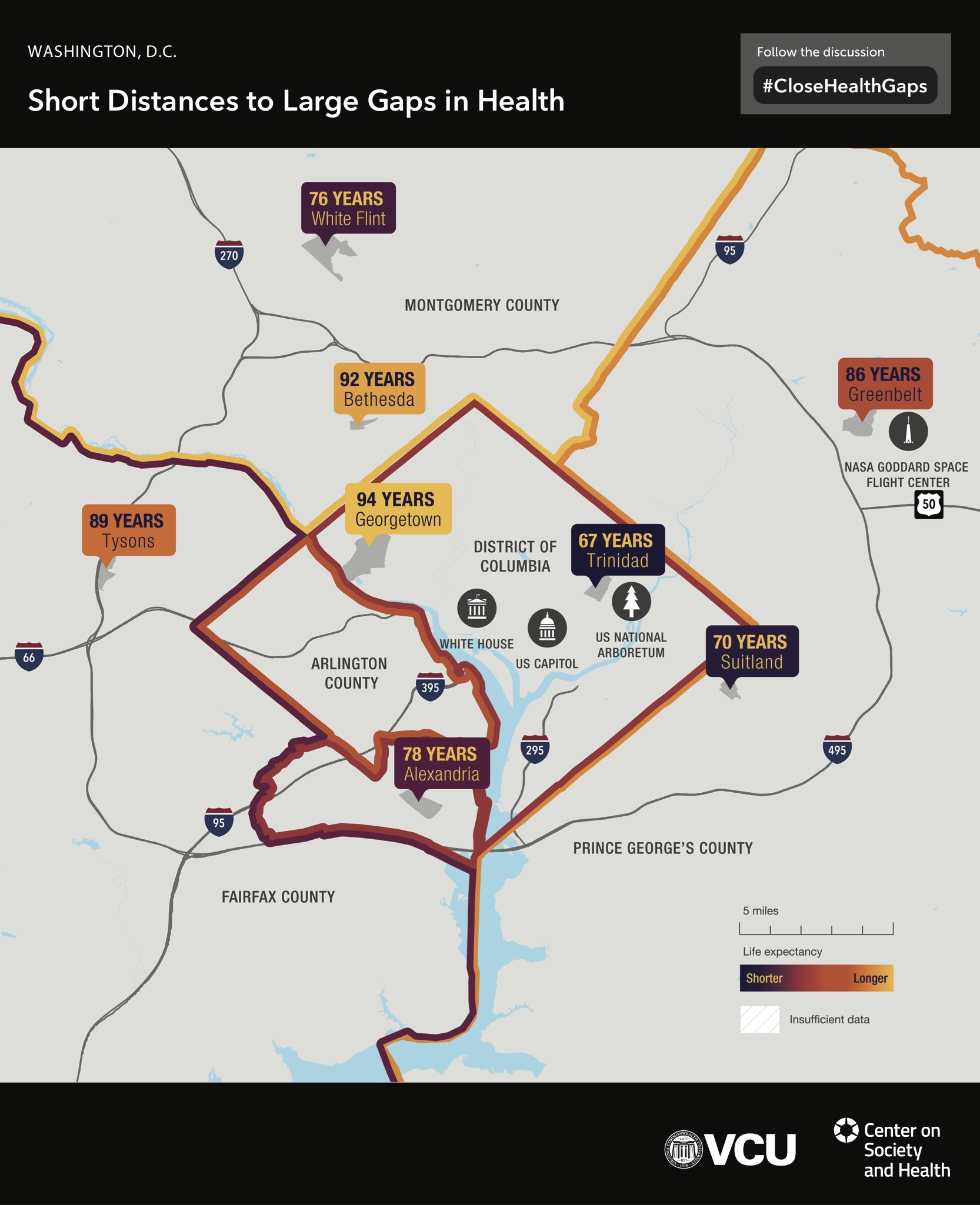As part of its regional planning effort, Region Forward, the Metropolitan Washington Council of Governments (COG) commissioned the Center to study disparities in health—and the factors that shape health—across the region’s 1,223 census tracts. The public officials in COG sought not only to document the health disparities that exist in the region, but also to identify the policy opportunities for improving health through improved education, economic wellbeing, housing, and other sectors.
 The study examined 10 geographic areas: the District of Columbia; Maryland (Charles County, Frederick County, Montgomery County, Prince George’s County); and Virginia (City of Alexandria, Arlington County, Fairfax County, Loudoun County, and Prince William County). In addition to calculating life expectancy by census tract, researchers at the Center produced a new tool for gauging the opportunity for health, the Metropolitan Washington Healthy Places Index (HPI), which is based on data from 48 indicators spanning six domains. Statistical methods were used to measure the influence of these domains on life expectancy. The Metropolitan Washington HPI sums up this information as a score, ranging from 0 to 100, to quantify the conditions for health in each census tract.
The study examined 10 geographic areas: the District of Columbia; Maryland (Charles County, Frederick County, Montgomery County, Prince George’s County); and Virginia (City of Alexandria, Arlington County, Fairfax County, Loudoun County, and Prince William County). In addition to calculating life expectancy by census tract, researchers at the Center produced a new tool for gauging the opportunity for health, the Metropolitan Washington Healthy Places Index (HPI), which is based on data from 48 indicators spanning six domains. Statistical methods were used to measure the influence of these domains on life expectancy. The Metropolitan Washington HPI sums up this information as a score, ranging from 0 to 100, to quantify the conditions for health in each census tract.
Among the study’s major findings was that life expectancy differed by as much as 27 years across the region. A baby born in the Foxhill area of Georgetown may live a generation longer than one born just miles away in a neighborhood of Trinidad near Gallaudet University. The HPI calculations revealed that education and economic resources together explained 60% of this variation. Other important factors included housing, transportation, air quality, and access to health care, in decreasing order of importance.
Maps in the report pinpoint specific areas with low HPI scores (less favorable conditions for health). The report draws stark contrasts between living conditions faced by residents, who are often people of color and immigrants, and those living in more affluent areas in close proximity. It discusses the history of the region, dating to the Colonial era, which led to segregation and economic isolation of certain neighborhoods.
The bottom line: Access to opportunity in the region is uneven. Health care is a necessary but insufficient solution. The report, titled Uneven Opportunities: How Conditions for Wellness Vary Across the Metropolitan Washington Region, emphasized that initiatives to improve education, promote economic opportunity, and invest in community infrastructure are “win-win” solutions that can improve public health while also stimulating the economy and the growth of the region. Tools like the HPI index can help target strategies to communities in need and stimulate cross-sectoral partnerships.
Read more at the COG website and download the Uneven Opportunities report here. In addition to the main report, the project also produced 80 maps for 10 jurisdictions, a technical appendix detailing methods, and a raw data file for use by local health departments and COG.
The Metropolitan Washington Healthy Places Index (HPI) builds upon the methods and approach of the California Healthy Places Index, which was jointly developed by the Public Health Alliance of Southern California and Virginia Commonwealth University’s Center on Society and Health.
_______
Everyone should have the opportunity to live a healthy life. Our health is shaped by many community conditions such as economics, education, housing, and social factors. The Healthy Places Index family of projects combines community characteristics into a single indexed HPI Score, produced at the neighborhood level. HPI scores can be compared across neighborhoods to paint an overall picture of health and well-being in each community. The Healthy Places Index’s developers are the Public Health Alliance of Southern California and Virginia Commonwealth University’s Center on Society and Health (VCU). The Healthy Places Index family of projects is free to use, reproduce, and distribute for noncommercial purposes, including educational, government and community uses, with proper attribution to the Public Health Alliance of Southern California and VCU. Use of these publications does not imply endorsement by the Public Health Alliance of Southern California or VCU. More information about the Healthy Places Index family of projects can be found at http://healthyplacesindex.org/.